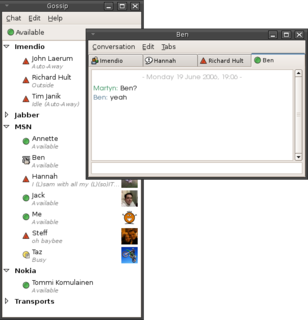
Warez is a common computing and broader cultural term referring to pirated software that is distributed via the Internet. Warez is used most commonly as a noun, a plural form of ware, and is intended to be pronounced like the word wares. The circumvention of copy protection (cracking) is an essential step in generating warez, and based on this common mechanism, the software-focused definition has been extended to include other copyright-protected materials, including movies and games. The global array of warez groups has been referred to as "The Scene", deriving from its earlier description as "the warez scene". Distribution and trade of copyrighted works without payment of fees or royalties generally violates national and international copyright laws and agreements. The term warez covers supported as well as unsupported (abandonware) items, and legal prohibitions governing creation and distribution of warez cover both profit-driven and "enthusiast" generators and distributors of such items.

An email client, email reader or, more formally, message user agent (MUA) or mail user agent is a computer program used to access and manage a user's email.

Instant messaging (IM) technology is a type of online chat allowing real-time text transmission over the Internet or another computer network. Messages are typically transmitted between two or more parties, when each user inputs text and triggers a transmission to the recipient(s), who are all connected on a common network. It differs from email in that conversations over instant messaging happen in real-time. Most modern IM applications use push technology and also add other features such as emojis, file transfer, chatbots, voice over IP, or video chat capabilities.

Phishing is a type of social engineering where an attacker sends a fraudulent message designed to trick a person into revealing sensitive information to the attacker or to deploy malicious software on the victim's infrastructure like ransomware. Phishing attacks have become increasingly sophisticated and often transparently mirror the site being targeted, allowing the attacker to observe everything while the victim is navigating the site, and transverse any additional security boundaries with the victim. As of 2020, phishing is by far the most common attack performed by cybercriminals, the FBI's Internet Crime Complaint Centre recording over twice as many incidents of phishing than any other type of computer crime.

In the context of information security, social engineering is the psychological manipulation of people into performing actions or divulging confidential information. This differs from social engineering within the social sciences, which does not concern the divulging of confidential information. A type of confidence trick for the purpose of information gathering, fraud, or system access, it differs from a traditional "con" in that it is often one of many steps in a more complex fraud scheme.

Internet security is a branch of computer security. It encompasses the Internet, browser security, web site security, and network security as it applies to other applications or operating systems as a whole. Its objective is to establish rules and measures to use against attacks over the Internet. The Internet is an inherently insecure channel for information exchange, with high risk of intrusion or fraud, such as phishing, online viruses, trojans, ransomware and worms.

A one-time password (OTP), also known as a one-time PIN, one-time authorization code (OTAC) or dynamic password, is a password that is valid for only one login session or transaction, on a computer system or other digital device. OTPs avoid several shortcomings that are associated with traditional (static) password-based authentication; a number of implementations also incorporate two-factor authentication by ensuring that the one-time password requires access to something a person has as well as something a person knows.
A transaction authentication number (TAN) is used by some online banking services as a form of single use one-time passwords (OTPs) to authorize financial transactions. TANs are a second layer of security above and beyond the traditional single-password authentication.
A spoofed URL describes one website that poses as another website. It sometimes applies a mechanism that exploits bugs in web browser technology, allowing a malicious computer attack. Such attacks are most effective against computers that lack recent security patches. Others are designed for the purpose of a parody.
Sub7, or SubSeven or Sub7Server, is a Trojan horse program originally released in 1999. Its name was derived by spelling NetBus backwards ("suBteN") and swapping "ten" with "seven". As of June 2021, the development of Sub7 is being continued.
A password manager is a computer program that allows users to store, generate, and manage their passwords for local applications and online services.
The Ten Commandments of Computer Ethics were created in 1992 by the Washington, D.C. based Computer Ethics Institute. The commandments were introduced in the paper "In Pursuit of a 'Ten Commandments' for Computer Ethics" by Ramon C. Barquin as a means to create "a set of standards to guide and instruct people in the ethical use of computers." They follow the Internet Advisory Board's memo on ethics from 1987. The Ten Commandments of Computer Ethics copies the archaic style of the Ten Commandments from the King James Bible.
Voice phishing, or vishing, is the use of telephony to conduct phishing attacks.
Internet safety or online safety or cyber safety and E-Safety is trying to be safe on the internet and is the act of maximizing a user's awareness of personal safety and security risks to private information and property associated with using the internet, and the self-protection from computer crime.

An evil twin is a fraudulent Wi-Fi access point that appears to be legitimate but is set up to eavesdrop on wireless communications. The evil twin is the wireless LAN equivalent of the phishing scam.
Torpig, also known as Anserin or Sinowal is a type of botnet spread through systems compromised by the Mebroot rootkit by a variety of trojan horses for the purpose of collecting sensitive personal and corporate data such as bank account and credit card information. It targets computers that use Microsoft Windows, recruiting a network of zombies for the botnet. Torpig circumvents antivirus software through the use of rootkit technology and scans the infected system for credentials, accounts and passwords as well as potentially allowing attackers full access to the computer. It is also purportedly capable of modifying data on the computer, and can perform man-in-the-browser attacks.
Internet fraud prevention is the act of stopping various types of internet fraud. Due to the many different ways of committing fraud over the Internet, such as stolen credit cards, identity theft, phishing, and chargebacks, users of the Internet, including online merchants, financial institutions and consumers who make online purchases, must make sure to avoid or minimize the risk of falling prey to such scams.
Credit card fraud is an inclusive term for fraud committed using a payment card, such as a credit card or debit card. The purpose may be to obtain goods or services or to make payment to another account, which is controlled by a criminal. The Payment Card Industry Data Security Standard is the data security standard created to help financial institutions process card payments securely and reduce card fraud.

Multi-factor authentication is an electronic authentication method in which a user is granted access to a website or application only after successfully presenting two or more pieces of evidence to an authentication mechanism: knowledge, possession, and inherence. MFA protects user data—which may include personal identification or financial assets—from being accessed by an unauthorized third party that may have been able to discover, for example, a single password.
Social hacking describes the act of attempting to manipulate outcomes of social behaviour through orchestrated actions. The general function of social hacking is to gain access to restricted information or to a physical space without proper permission. Most often, social hacking attacks are achieved by impersonating an individual or group who is directly or indirectly known to the victims or by representing an individual or group in a position of authority. This is done through pre-meditated research and planning to gain victims’ confidence. Social hackers take great measures to present overtones of familiarity and trustworthiness to elicit confidential or personal information. Social hacking is most commonly associated as a component of “social engineering”.







